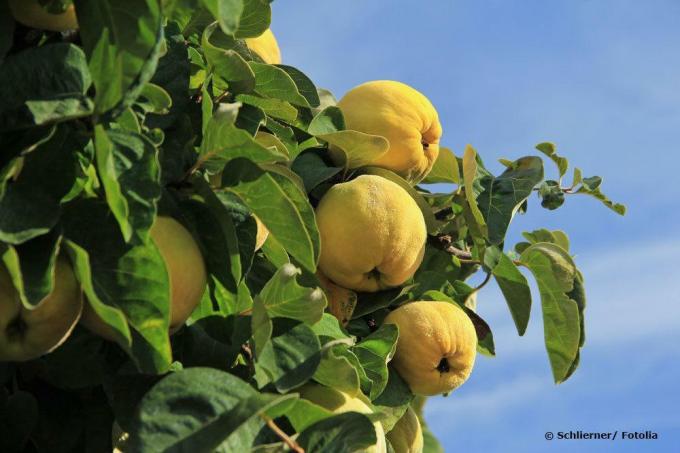
table of contents
- Can you eat quinces raw?
- Edible varieties
- Eat quince raw
- Prepare quinces
Quince is one of the most popular types of fruit that is boiled down and processed into numerous sweet fruit products. Cydonia oblonga has been known for over 4,000 years and was cultivated for the first time in the Caucasus and spreads from there to southern Europe, Asia and even Argentina. In Europe the quince is made into jam, liqueur or compote, but is it possible to eat the quince raw?
Can you eat quinces raw?
The answer to the question of whether quinces can be eaten raw can be answered with a yes and no. The reason: the growing area. Quinces grown in Central Europe cannot be eaten raw, as the few hours of sunshine and cool temperatures mean that they develop many bitter substances that destroy the sweet enjoyment. In the original range, however, the fruits ripen with fewer bitter substances, which makes it possible to eat them directly. Theoretically, you could eat any quince without preparation, but old varieties in particular have a lot of bitter substances and extremely hard peels. Rather, rely on new breeds and proven varieties that counteract this problem.
tip: In Southeastern Europe, South America, the Caucasus and Turkey, quinces are mostly eaten raw, as the plants there get enough sun and are therefore sweeter and softer. If you find fresh quinces at a market while on holiday, you should definitely try them out once.
Edible varieties
If you want to enjoy Cydonia oblonga like an apple or a pear instead of warmed up, you should try different varieties or grow them yourself. A large part of these can be found as cultivated forms, while the other part are classic varieties from South America or the area around the Black and Caspian Sea, less often the Mediterranean. Due to the numerous hours of sunshine and a higher climate, these are better tolerated in their raw state. The following list gives you an overview of the varieties that you can eat raw:
- 'Raw Foods'
- 'Honey quince'
- 'Shirin'
- ,Orange'
- 'Aromatnaya'
- 'Karp's Sweet'
- 'Crimea'
- 'Kuganskaya'
- 'Miagkoplodnaya Volgogradskaya'
One thing that all of these strains have in common is flavor. They are reminiscent of sour apples, but are more floury. Some varieties such as 'Orange' also have a gentle citrus aroma that spreads pleasantly in the mouth. Experience has shown that the varieties “Karp’s Sweet” from Argentina and “Miagkoplodnaja Wolgogradskaja”, the “soft meat”, are particularly aromatic and popular. 'Crimea', on the other hand, has a slightly bland taste, while 'Kuganskaya' is a bit harder and bitter and therefore not quite as popular. The easiest varieties to get in Germany are 'Rohköstler', 'Shirin' from Turkey and 'Honigquitte'. With a little luck you can find them in the nearest deli.
tip: Many of the above varieties are unlikely to be available at the greengrocer, health food store or supermarket around the corner. It is best to contact fruit importers or online shops that offer exotic, tropical or Mediterranean fruits.
Eat quince raw
If you have a quince in the garden and want to try its fruits, that's no problem. The fruits are not harmful to health, but children in particular can burp due to the tannins, so they should perhaps avoid eating them raw. If you use one of the varieties mentioned above, this is of course not a problem. Only the following plant parts of the Cydonia oblonga are harmful and not suitable for consumption:
- Fluff: contains most of the bitter substances
- Seeds: contain a high content of hydrocyanic acid
You can eat the rest of the quince completely, especially the varieties already mentioned. With other cultivars, the shell is often very hard and the meat woody, which makes further processing into compotes, purees, juices and more useful. However, all types of quince are prepared in the same way to make them palatable.

Prepare quinces
The following instructions will help you to treat the fruits appropriately so that you can eat them directly in order to reduce the content of bitter substances:
1. Start with the fluffcovering the peel of the quince. For this it is not washed off, but simply rubbed off. Use either a cotton cloth or a vegetable brush to rub. Brass brushes are traditionally used to prepare quince, but they damage the shell, which is a pity, especially with varieties that can be consumed raw. The reason: Vitamins are thereby removed from the shell.
2. The next point differs depending on the variety. If you have any of the above varieties available, you do not need to consume them prior to consumption peel. With other varieties, however, it is important to peel them, as the peel is very hard and bitter. Use either a knife or a peeler to do this. You can peel quinces like apples or pears.
3. Now cut the quince in half so you can access that Core casing to have. You have to remove this completely because, unlike the kernels of apples, the quince seeds are not edible. Be careful not to eat the seeds with the quince. The high content of Hydrocyanic acid can be harmful in large quantities, especially for children and sensitive people.
4. Then you can either cut the quince into slices or pieces and enjoy like an apple or a pear. If you have large quantities of quinces available, you should definitely boil down some and conjure up sweet spreads or jams from them, as the fruits develop their full aroma can.


